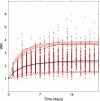Warfarin dose prediction in children using pharmacometric bridging--comparison with published pharmacogenetic dosing algorithms
- PMID: 23307232
- PMCID: PMC3651819
- DOI: 10.1007/s00228-012-1466-4
Warfarin dose prediction in children using pharmacometric bridging--comparison with published pharmacogenetic dosing algorithms
Erratum in
- Eur J Clin Pharmacol. 2013 Sep;69(9):1737
Abstract
Purpose: Numerous studies have investigated causes of warfarin dose variability in adults, whereas studies in children are limited both in numbers and size. Mechanism-based population modelling provides an opportunity to condense and propagate prior knowledge from one population to another. The main objectives with this study were to evaluate the predictive performance of a theoretically bridged adult warfarin model in children, and to compare accuracy in dose prediction relative to published warfarin algorithms for children.
Method: An adult population pharmacokinetic/pharmacodynamic (PK/PD) model for warfarin, with CYP2C9 and VKORC1 genotype, age and target international normalized ratio (INR) as dose predictors, was bridged to children using allometric scaling methods. Its predictive properties were evaluated in an external data set of children 0-18 years old, including comparison of dose prediction accuracy with three pharmacogenetics-based algorithms for children.
Results: Overall, the bridged model predicted INR response well in 64 warfarin-treated Swedish children (median age 4.3 years), but with a tendency to overpredict INR in children ≤2 years old. The bridged model predicted 20 of 49 children (41 %) within ± 20 % of actual maintenance dose (median age 7.2 years). In comparison, the published dosing algorithms predicted 33-41 % of the children within ±20 % of actual dose. Dose optimization with the bridged model based on up to three individual INR observations increased the proportion within ±20 % of actual dose to 70 %.
Conclusion: A mechanism-based population model developed on adult data provides a promising first step towards more individualized warfarin therapy in children.
Figures




Similar articles
-
Validation of pharmacogenetic algorithms and warfarin dosing table in Egyptian patients.Int J Clin Pharm. 2012 Dec;34(6):837-44. doi: 10.1007/s11096-012-9678-3. Epub 2012 Jul 27. Int J Clin Pharm. 2012. PMID: 22851439
-
Ability of VKORC1 and CYP2C9 to predict therapeutic warfarin dose during the initial weeks of therapy.J Thromb Haemost. 2010 Jan;8(1):95-100. doi: 10.1111/j.1538-7836.2009.03677.x. Epub 2009 Oct 30. J Thromb Haemost. 2010. PMID: 19874474 Free PMC article. Clinical Trial.
-
Accuracy assessment of pharmacogenetically predictive warfarin dosing algorithms in patients of an academic medical center anticoagulation clinic.J Thromb Thrombolysis. 2010 Aug;30(2):220-5. doi: 10.1007/s11239-010-0459-3. J Thromb Thrombolysis. 2010. PMID: 20204461
-
Optimal dosing of warfarin and other coumarin anticoagulants: the role of genetic polymorphisms.Arch Toxicol. 2013 Mar;87(3):407-20. doi: 10.1007/s00204-013-1013-9. Epub 2013 Feb 2. Arch Toxicol. 2013. PMID: 23376975 Review.
-
Pharmacogenetic differences between warfarin, acenocoumarol and phenprocoumon.Thromb Haemost. 2008 Dec;100(6):1052-7. Thromb Haemost. 2008. PMID: 19132230 Review.
Cited by
-
Prediction of Warfarin Dose in Pediatric Patients: An Evaluation of the Predictive Performance of Several Models.J Pediatr Pharmacol Ther. 2016 May-Jun;21(3):224-32. doi: 10.5863/1551-6776-21.3.224. J Pediatr Pharmacol Ther. 2016. PMID: 27453700 Free PMC article.
-
Evaluation of the effects of ontogenetic or maturation functions and chronic heart failure on the model analysis for the dose-response relationship of warfarin in Japanese children.Eur J Clin Pharmacol. 2019 Jul;75(7):913-920. doi: 10.1007/s00228-019-02652-x. Epub 2019 Mar 8. Eur J Clin Pharmacol. 2019. PMID: 30848333
-
Comparing Two Methods of Tablet Manipulation to Adjust the Warfarin Dose in Paediatric Care.Pharmaceutics. 2020 Apr 18;12(4):375. doi: 10.3390/pharmaceutics12040375. Pharmaceutics. 2020. PMID: 32325777 Free PMC article.
-
Development of a novel individualized warfarin dose algorithm based on a population pharmacokinetic model with improved prediction accuracy for Chinese patients after heart valve replacement.Acta Pharmacol Sin. 2017 Mar;38(3):434-442. doi: 10.1038/aps.2016.163. Epub 2017 Feb 20. Acta Pharmacol Sin. 2017. PMID: 28216623 Free PMC article.
-
The past, present and perhaps future of pharmacovigilance: homage to Folke Sjoqvist.Eur J Clin Pharmacol. 2013 May;69 Suppl 1:33-41. doi: 10.1007/s00228-013-1486-8. Epub 2013 May 3. Eur J Clin Pharmacol. 2013. PMID: 23640186
References
-
- Monagle P, Chan AKC, Goldenberg NA, Ichord RN, Journeycake JM, Nowak-Gottl U, Vesely SK. Antithrombotic Therapy in Neonates and Children: Antithrombotic Therapy and Prevention of Thrombosis, 9th ed: American College of Chest Physicians Evidence-Based Clinical Practice Guidelines. Chest. 2012;141(2 suppl):e737S–e801S. doi: 10.1378/chest.11-2308. - DOI - PMC - PubMed
Publication types
MeSH terms
Substances
LinkOut - more resources
Full Text Sources
Other Literature Sources
Medical

